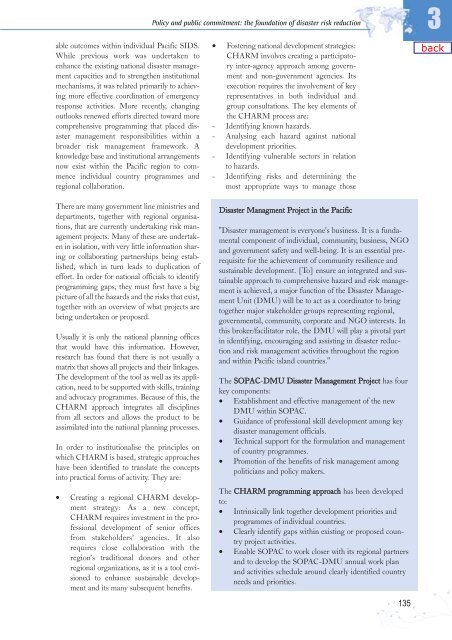Living with Risk. A global review of disaster reduction initiatives
Living with Risk. A global review of disaster reduction initiatives
Living with Risk. A global review of disaster reduction initiatives
You also want an ePaper? Increase the reach of your titles
YUMPU automatically turns print PDFs into web optimized ePapers that Google loves.
able outcomes <strong>with</strong>in individual Pacific SIDS.<br />
While previous work was undertaken to<br />
enhance the existing national <strong>disaster</strong> management<br />
capacities and to strengthen institutional<br />
mechanisms, it was related primarily to achieving<br />
more effective coordination <strong>of</strong> emergency<br />
response activities. More recently, changing<br />
outlooks renewed efforts directed toward more<br />
comprehensive programming that placed <strong>disaster</strong><br />
management responsibilities <strong>with</strong>in a<br />
broader risk management framework. A<br />
knowledge base and institutional arrangements<br />
now exist <strong>with</strong>in the Pacific region to commence<br />
individual country programmes and<br />
regional collaboration.<br />
Policy and public commitment: the foundation <strong>of</strong> <strong>disaster</strong> risk <strong>reduction</strong><br />
• Fostering national development strategies:<br />
CHARM involves creating a participatory<br />
inter-agency approach among government<br />
and non-government agencies. Its<br />
execution requires the involvement <strong>of</strong> key<br />
representatives in both individual and<br />
group consultations. The key elements <strong>of</strong><br />
the CHARM process are:<br />
- Identifying known hazards.<br />
- Analysing each hazard against national<br />
development priorities.<br />
- Identifying vulnerable sectors in relation<br />
to hazards.<br />
- Identifying risks and determining the<br />
most appropriate ways to manage those<br />
3<br />
There are many government line ministries and<br />
departments, together <strong>with</strong> regional organisations,<br />
that are currently undertaking risk management<br />
projects. Many <strong>of</strong> these are undertaken<br />
in isolation, <strong>with</strong> very little information sharing<br />
or collaborating partnerships being established,<br />
which in turn leads to duplication <strong>of</strong><br />
effort. In order for national <strong>of</strong>ficials to identify<br />
programming gaps, they must first have a big<br />
picture <strong>of</strong> all the hazards and the risks that exist,<br />
together <strong>with</strong> an overview <strong>of</strong> what projects are<br />
being undertaken or proposed.<br />
Usually it is only the national planning <strong>of</strong>fices<br />
that would have this information. However,<br />
research has found that there is not usually a<br />
matrix that shows all projects and their linkages.<br />
The development <strong>of</strong> the tool as well as its application,<br />
need to be supported <strong>with</strong> skills, training<br />
and advocacy programmes. Because <strong>of</strong> this, the<br />
CHARM approach integrates all disciplines<br />
from all sectors and allows the product to be<br />
assimilated into the national planning processes.<br />
In order to institutionalise the principles on<br />
which CHARM is based, strategic approaches<br />
have been identified to translate the concepts<br />
into practical forms <strong>of</strong> activity. They are:<br />
• Creating a regional CHARM development<br />
strategy: As a new concept,<br />
CHARM requires investment in the pr<strong>of</strong>essional<br />
development <strong>of</strong> senior <strong>of</strong>fices<br />
from stakeholders’ agencies. It also<br />
requires close collaboration <strong>with</strong> the<br />
region’s traditional donors and other<br />
regional organizations, as it is a tool envisioned<br />
to enhance sustainable development<br />
and its many subsequent benefits.<br />
Disaster Managment Project in the Pacific<br />
"Disaster management is everyone's business. It is a fundamental<br />
component <strong>of</strong> individual, community, business, NGO<br />
and government safety and well-being. It is an essential prerequisite<br />
for the achievement <strong>of</strong> community resilience and<br />
sustainable development. [To] ensure an integrated and sustainable<br />
approach to comprehensive hazard and risk management<br />
is achieved, a major function <strong>of</strong> the Disaster Management<br />
Unit (DMU) will be to act as a coordinator to bring<br />
together major stakeholder groups representing regional,<br />
governmental, community, corporate and NGO interests. In<br />
this broker/facilitator role, the DMU will play a pivotal part<br />
in identifying, encouraging and assisting in <strong>disaster</strong> <strong>reduction</strong><br />
and risk management activities throughout the region<br />
and <strong>with</strong>in Pacific island countries."<br />
The SOPAC-DMU Disaster Management Project has four<br />
key components:<br />
• Establishment and effective management <strong>of</strong> the new<br />
DMU <strong>with</strong>in SOPAC.<br />
• Guidance <strong>of</strong> pr<strong>of</strong>essional skill development among key<br />
<strong>disaster</strong> management <strong>of</strong>ficials.<br />
• Technical support for the formulation and management<br />
<strong>of</strong> country programmes.<br />
• Promotion <strong>of</strong> the benefits <strong>of</strong> risk management among<br />
politicians and policy makers.<br />
The CHARM programming approach has been developed<br />
to:<br />
• Intrinsically link together development priorities and<br />
programmes <strong>of</strong> individual countries.<br />
• Clearly identify gaps <strong>with</strong>in existing or proposed country<br />
project activities.<br />
• Enable SOPAC to work closer <strong>with</strong> its regional partners<br />
and to develop the SOPAC-DMU annual work plan<br />
and activities schedule around clearly identified country<br />
needs and priorities.<br />
135

















